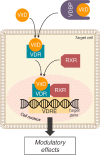Cellular and molecular mechanisms of vitamin D in food allergy
- PMID: 29577619
- PMCID: PMC6010899
- DOI: 10.1111/jcmm.13607
Cellular and molecular mechanisms of vitamin D in food allergy
Abstract
Food allergies are becoming increasingly prevalent, especially in young children. Epidemiological evidence from the past decade suggests a role of vitamin D in food allergy pathogenesis. Links have been made between variations in sunlight exposure, latitude, birth season and vitamin D status with food allergy risk. Despite the heightened interest in vitamin D in food allergies, it remains unclear by which exact mechanism(s) it acts. An understanding of the roles vitamin D plays within the immune system at the cellular and genetic levels, as well as the interplay between the microbiome and vitamin D, will provide insight into the importance of the vitamin in food allergies. Here, we discuss the effect of vitamin D on immune cell maturation, differentiation and function; microbiome; genetic and epigenetic regulation (eg DNA methylation); and how these processes are implicated in food allergies.
Keywords: epigenetics; food allergy; genetics; microbiome; vitamin D.
© 2018 The Authors. Journal of Cellular and Molecular Medicine published by John Wiley & Sons Ltd and Foundation for Cellular and Molecular Medicine.
Figures

References
-
- Prescott S, Allen K. Food allergy: riding the second wave of the allergy epidemic. Pediatr Allergy Immunol. 2011;22:155‐160. - PubMed
-
- Hong X, Wang X. Epigenetics and development of food allergy (FA) in early childhood. Curr Allergy Asthma Rep. 2014;14:460. - PubMed
-
- Sicherer SH, Muñoz‐Furlong A, Godbold JH, Sampson HA. US prevalence of self‐reported peanut, tree nut, and sesame allergy: 11‐year follow‐up. J Allergy Clin Immunol. 2010;125:1322‐1326. - PubMed
-
- Branum AM, Lukacs SL. Food allergy among children in the United States. Pediatrics. 2009;124:1549. - PubMed
Publication types
MeSH terms
Substances
LinkOut - more resources
Full Text Sources
Other Literature Sources
Medical
Miscellaneous

